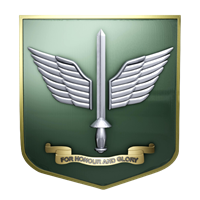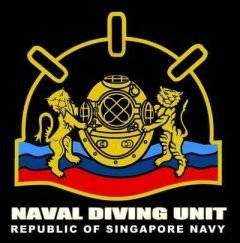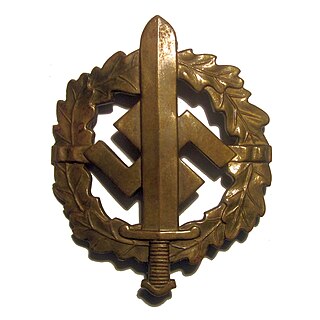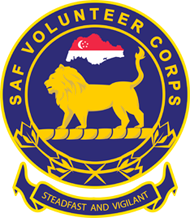Related Research Articles

Military recruit training, commonly known as basic training or boot camp, refers to the initial instruction of new military personnel. It is a physically and psychologically intensive process, which resocializes its subjects for the unique demands of military employment.
Lance corporal is a military rank, used by many English-speaking armed forces worldwide, and also by some police forces and other uniformed organisations. It is below the rank of corporal.

The Singapore Armed Forces (SAF) are the military services of the Republic of Singapore, responsible for protecting and defending the security interests and the sovereignty of the country. A military component of the Ministry of Defence (MINDEF), the armed forces have four service branches: the Army, the Navy, the Air Force, and the Digital and Intelligence Service. An integrated force, it is one of the most capable, robust, technologically sophisticated and powerful militaries in Southeast Asia and the surrounding regions. The SAF is headed by the chief of defence force, appointed by the president of Singapore, on the advice of the Cabinet.
The National Physical Fitness Award (NAPFA) is a standard physical fitness test for Singaporeans as part of Singapore's Sports For Life programme. NAPFA was launched in January 1982 as a standardised assessment of overall fitness for the general population.

Commandos is the special forces formation of the Singapore Army responsible for conducting special operations. Commandos are tasked with infiltrating behind enemy lines by raiding and reconnaissance operations using airborne raids, helicopter assault and sea landings. The formation is made up of only one battalion, the 1st Commando Battalion, and is based in Hendon Camp.

The Naval Diving Unit (NDU), also referred to as the Naval Divers, is the special forces formation of the Republic of Singapore Navy (RSN) responsible for conducting special operations from sea, air, and land. The formation is made up of six squadrons, specialising in explosive ordnance disposal, underwater demolition, maritime security operations, and combatant craft operations.

Total Defence is Singapore's whole-of-society national defence concept, based on the premise that every aspect of society contributes to the collective defence of the state.

Singapore maintains an active conscription system in accordance with the regulations set by the Government of Singapore, known as National Service (NS). This requires all qualified male Singaporean citizens and second-generation permanent residents to serve a period of active duty military service in the uniformed services.
The Volunteer Special Constabulary (VSC) in Singapore comprises volunteers from the general public. VSC officers are imbued with equal powers of a regular police officer to enforce law and order in Singapore. They wear the same police uniform as police officers as they patrol the streets and participate in public outreach events.

The Army Physical Fitness Test (APFT) was designed to test the muscular strength, endurance, and cardiovascular respiratory fitness of soldiers in the United States Army. Soldiers were scored based on their performance in three events consisting of the push-up, sit-up, and a two-mile run, ranging from 0 to 100 points in each event. A minimum score of 60 in each event was required to pass the test. The soldier's overall score was the sum of the points from the three events. If a soldier passed all three events, the total could have range from 180 to 300.
The Civil Defence Auxiliary Unit (CDAU) is part of the Singapore Civil Defence Force (SCDF) consisting of uniformed volunteers.

The advancement program for Scouts participating in the Scouts BSA program of the Boy Scouts of America is symbolized by the earning of seven ranks. The advancement program is often considered to be divided into two phases. The first phase from joining to First Class is designed to teach the scout Scoutcraft skills, how to participate in a group and to learn self-reliance. The Scout badge is awarded when the Scout demonstrates a rudimentary knowledge of the Scouting ideals and program. Tenderfoot, Second Class, and First Class have progressively harder requirements in the areas of Scoutcraft, physical fitness, citizenship, personal growth and Scout Spirit.

The German Armed Forces Badge for Military Proficiency is a decoration of the Bundeswehr, the armed forces of the Federal Republic of Germany.
The Trup Tindakan Cepat, or TTC, is an elite counter terrorism unit within the Malaysian Prison Department.
Within the framework of the training programme Air Training Corps cadets have the opportunity of taking part in many activities. On most Squadrons the only compulsory activities in the ATC year are attendance at various church parades, usually ATC Sunday and Remembrance Sunday. Many wings also insist that attending Wing Parade is compulsory.

The SA Sports Badge was a decoration of Nazi Germany that was issued between the years 1933 and 1945. It was a political version of the much more generic German Sports Badge, which was also issued in great numbers by the Nazis. At its center was a 57mm high Roman broad sword, superimposed over a Nazi swastika encircled by an wreath of oak leaves. It was a pin-back badge, but there was a cloth version, as well.
Orders and decorations conferred to civil defence personnel of the Singapore Civil Defence Force in Singapore, listed by order of precedence:
Royal Marines recruit training is the longest basic modern infantry training programme of any Commonwealth, or North Atlantic Treaty Organization (NATO) combat troops. The Royal Marines are the only part of the British Armed Forces where officers and other ranks are trained at the same location, the Commando Training Centre Royal Marines (CTCRM) at Lympstone, Devon. Much of the basic training is carried out on the rugged terrain of Dartmoor and Woodbury Common with a significant proportion taking place at night.

The Singapore Armed Forces Volunteer Corps (SAFVC) is a uniformed volunteer auxiliary branch of the Singapore Armed Forces. It was established on 13 October 2014 to allow Singaporean women, first generation permanent residents and naturalised citizens, all of whom would otherwise not be subject to an obligation to serve national service, to contribute their part towards Singapore's defence. It also aims to strengthen support for national service by understanding the duties of national servicemen.
References
- ↑ Uthaman, Yuvaraj (25 January 2012). "Reflecting about IPPT". Home Team News. Retrieved 22 December 2013.
- ↑ "Individual Physical Proficiency Test (IPPT)". Singapore Civil Defence Force. 29 April 2010. Retrieved 22 December 2013.
- 1 2 3 4 5 6 7 8 "Your Role as NSmen". Ministry of Defence. 6 September 2012. Retrieved 22 December 2013.
- 1 2 3 4 Chow, Jermyn (23 October 2013). "SAF soldiers' IPPT likely to change from next year". The Sunday Times. Retrieved 22 December 2013.
- ↑ "Individual Physical Proficiency Test (IPPT) FAQs". Army Fitness Centre. 4 May 2012. Retrieved 22 December 2013.
- ↑ Xue, Jianyue (24 July 2014). "MINDEF announces details of new IPPT scoring system". Today. Today. Retrieved 24 July 2014.
- ↑ "Maintenance Notification".
- ↑ "Enhancements to NS IPPT Management & Training System". ns.sg. July 2014. Archived from the original on 28 July 2014. Retrieved 30 July 2014.
- ↑ "Maintenance Notification".
- ↑ "ORNS Topics".
- ↑ "Look Smart with the New IPPT Badge". MINDEF. 25 March 2010. Retrieved 23 December 2013.